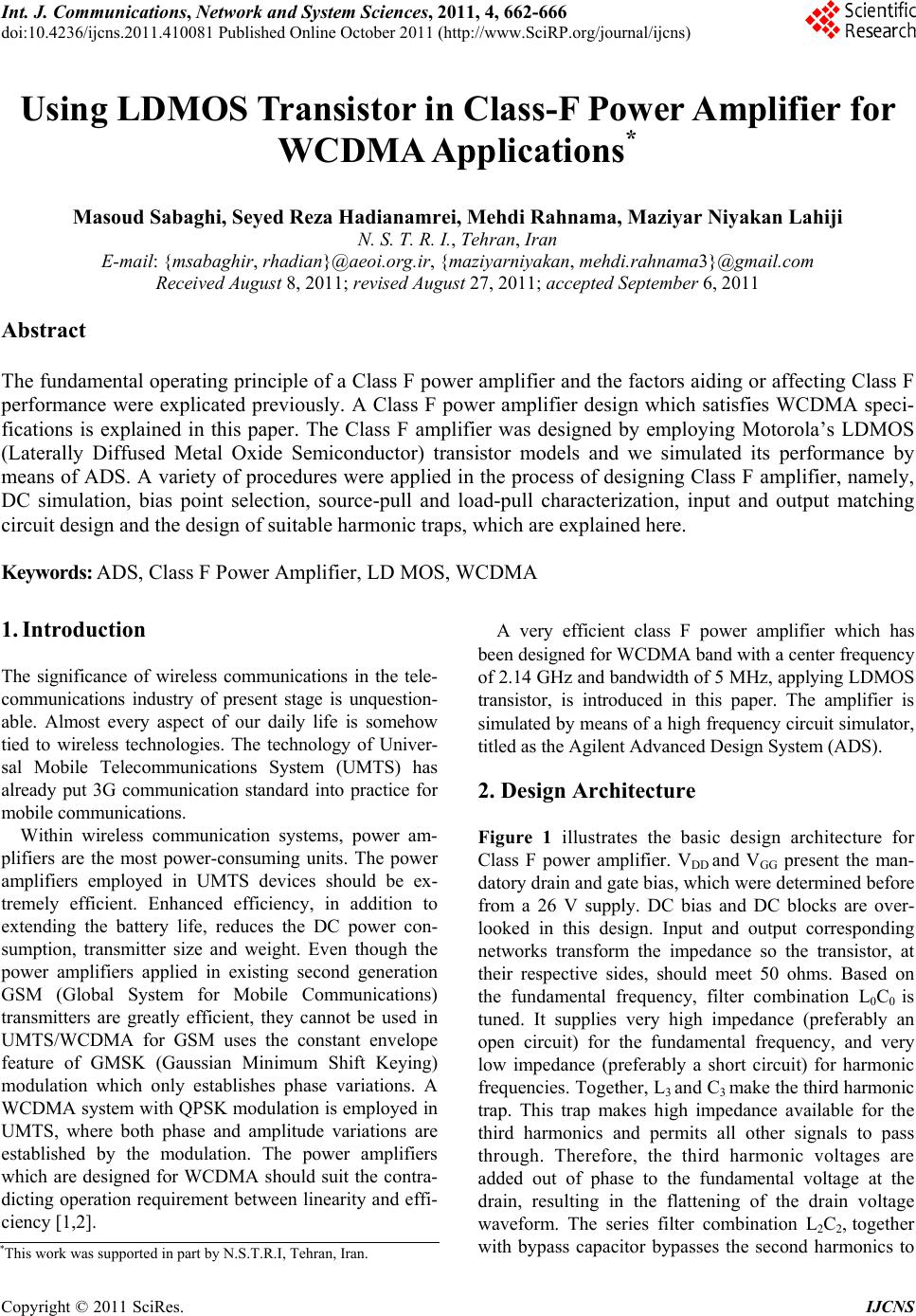
Int. J. Communications, Network and System Sciences, 2011, 4, 662-666
doi:10.4236/ijcns.2011.410081 Published Online October 2011 (http://www.SciRP.org/journal/ijcns)
Copyright © 2011 SciRes. IJCNS
Using LDMOS Transistor in Class-F Power Amplifier for
WCDMA Applications*
Masoud Sabaghi, Seyed Reza Hadianamrei, Mehdi Rahnama, Maziyar Niyakan Lahiji
N. S. T. R. I., Te hran, Iran
E-mail: {msabaghir, rhadian}@aeoi.org.ir, {maziyarniyakan, meh di .rahnama 3}@gmail.com
Received August 8, 2011; revised August 27, 2011; accepted September 6, 2011
Abstract
The fundamental operating principle of a Class F power amplifier and the factors aiding or affecting Class F
performance were explicated previously. A Class F power amplifier design which satisfies WCDMA speci-
fications is explained in this paper. The Class F amplifier was designed by employing Motorola’s LDMOS
(Laterally Diffused Metal Oxide Semiconductor) transistor models and we simulated its performance by
means of ADS. A variety of procedures were applied in the process of designing Class F amplifier, namely,
DC simulation, bias point selection, source-pull and load-pull characterization, input and output matching
circuit design and the design of suitable harmonic traps, which are explained here.
Keywords: ADS, Class F Power Amplifier, LD MOS, WCDMA
1. Introduction
The significance of wireless communications in the tele-
communications industry of present stage is unquestion-
able. Almost every aspect of our daily life is somehow
tied to wireless technologies. The technology of Univer-
sal Mobile Telecommunications System (UMTS) has
already put 3G communication standard into practice for
mobile communications.
Within wireless communication systems, power am-
plifiers are the most power-consuming units. The power
amplifiers employed in UMTS devices should be ex-
tremely efficient. Enhanced efficiency, in addition to
extending the battery life, reduces the DC power con-
sumption, transmitter size and weight. Even though the
power amplifiers applied in existing second generation
GSM (Global System for Mobile Communications)
transmitters are greatly efficient, they cannot be used in
UMTS/WCDMA for GSM uses the constant envelope
feature of GMSK (Gaussian Minimum Shift Keying)
modulation which only establishes phase variations. A
WCDMA system with QPSK modulation is employed in
UMTS, where both phase and amplitude variations are
established by the modulation. The power amplifiers
which are designed for WCDMA should suit the contra-
dicting operation requirement between linearity and effi-
ciency [1,2].
A very efficient class F power amplifier which has
been designed for WCDMA band with a center frequency
of 2.14 GHz and bandwidth of 5 MHz, applying LDMOS
transistor, is introduced in this paper. The amplifier is
simulated by means of a high frequency circuit simulator,
titled as the Agil ent Advanced Desi gn Sy st em (ADS).
2. Design Architecture
Figure 1 illustrates the basic design architecture for
Class F power amplifier. VDD and VGG present the man-
datory drain and gate bias, which were determined before
from a 26 V supply. DC bias and DC blocks are over-
looked in this design. Input and output corresponding
networks transform the impedance so the transistor, at
their respective sides, should meet 50 ohms. Based on
the fundamental frequency, filter combination L0C0 is
tuned. It supplies very high impedance (preferably an
open circuit) for the fundamental frequency, and very
low impedance (preferably a short circuit) for harmonic
frequencies. Together, L3 and C3 make the third harmonic
trap. This trap makes high impedance available for the
third harmonics and permits all other signals to pass
through. Therefore, the third harmonic voltages are
added out of phase to the fundamental voltage at the
drain, resulting in the flattening of the drain voltage
waveform. The series filter combination L2C2, together
with bypass capacitor bypasses the second harmonics to
*This work was supported in pa rt by N.S.T.R.I, Tehran, Iran.